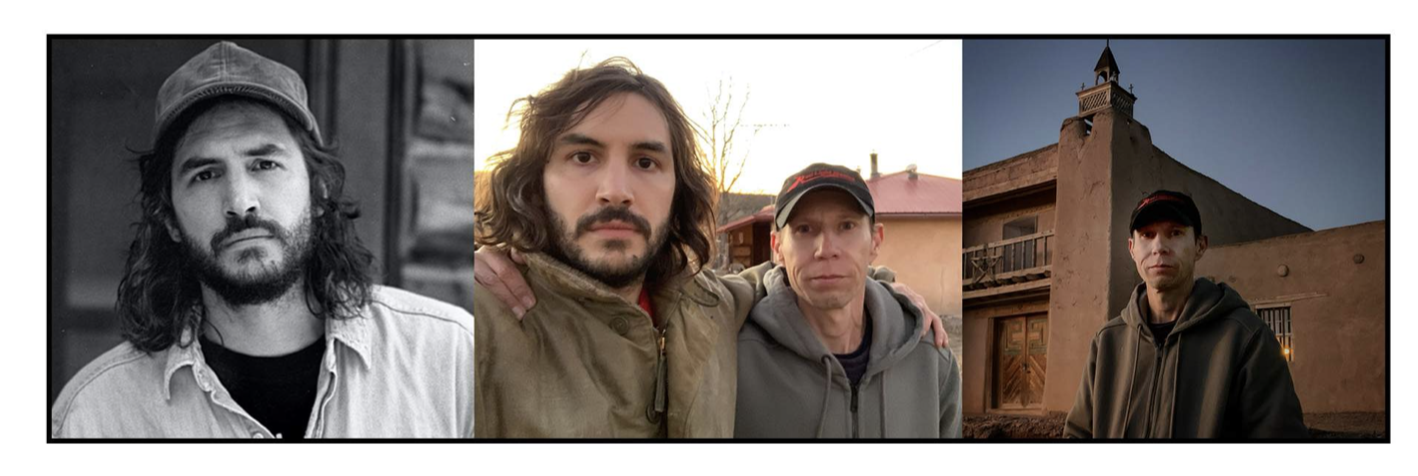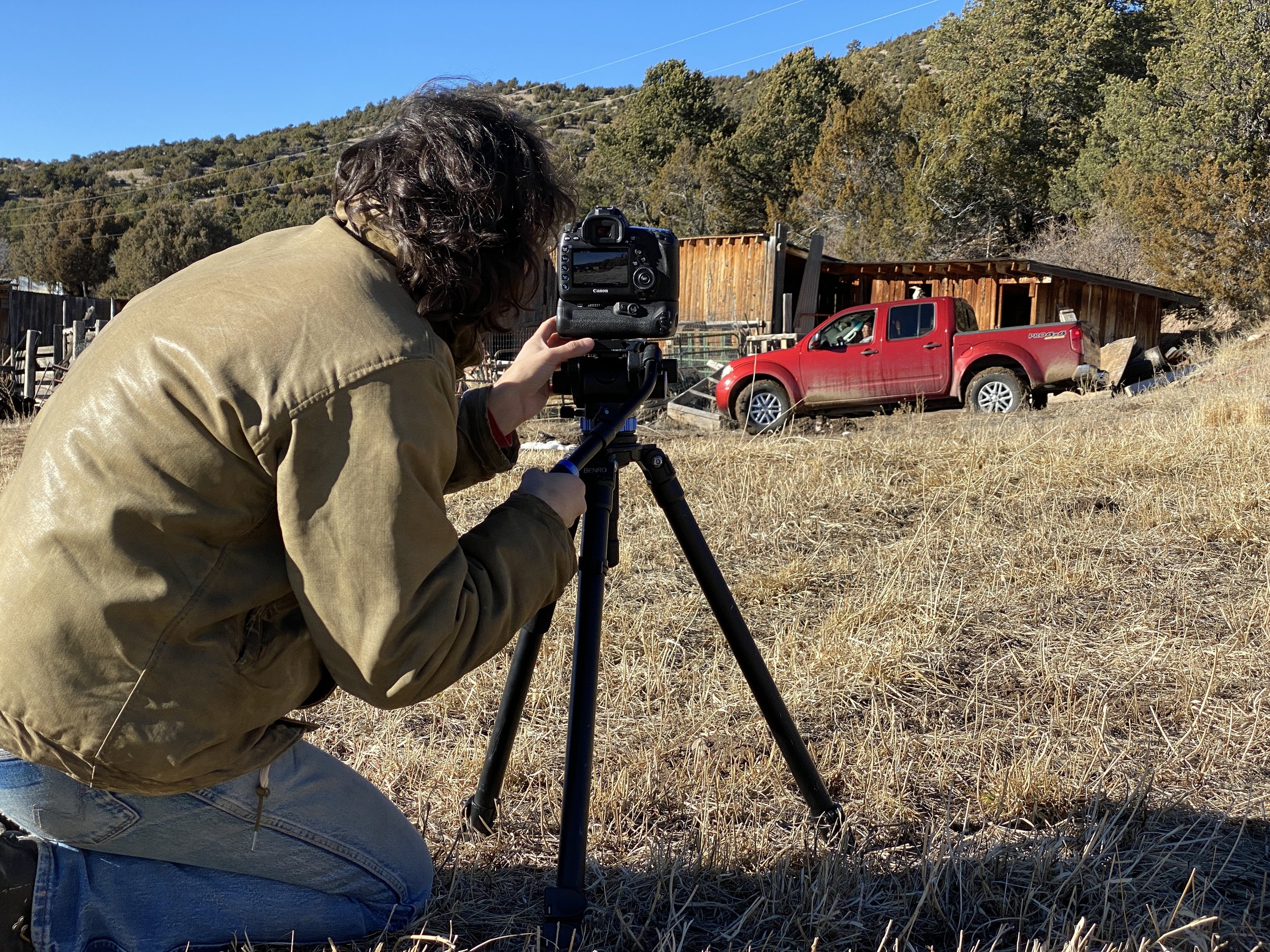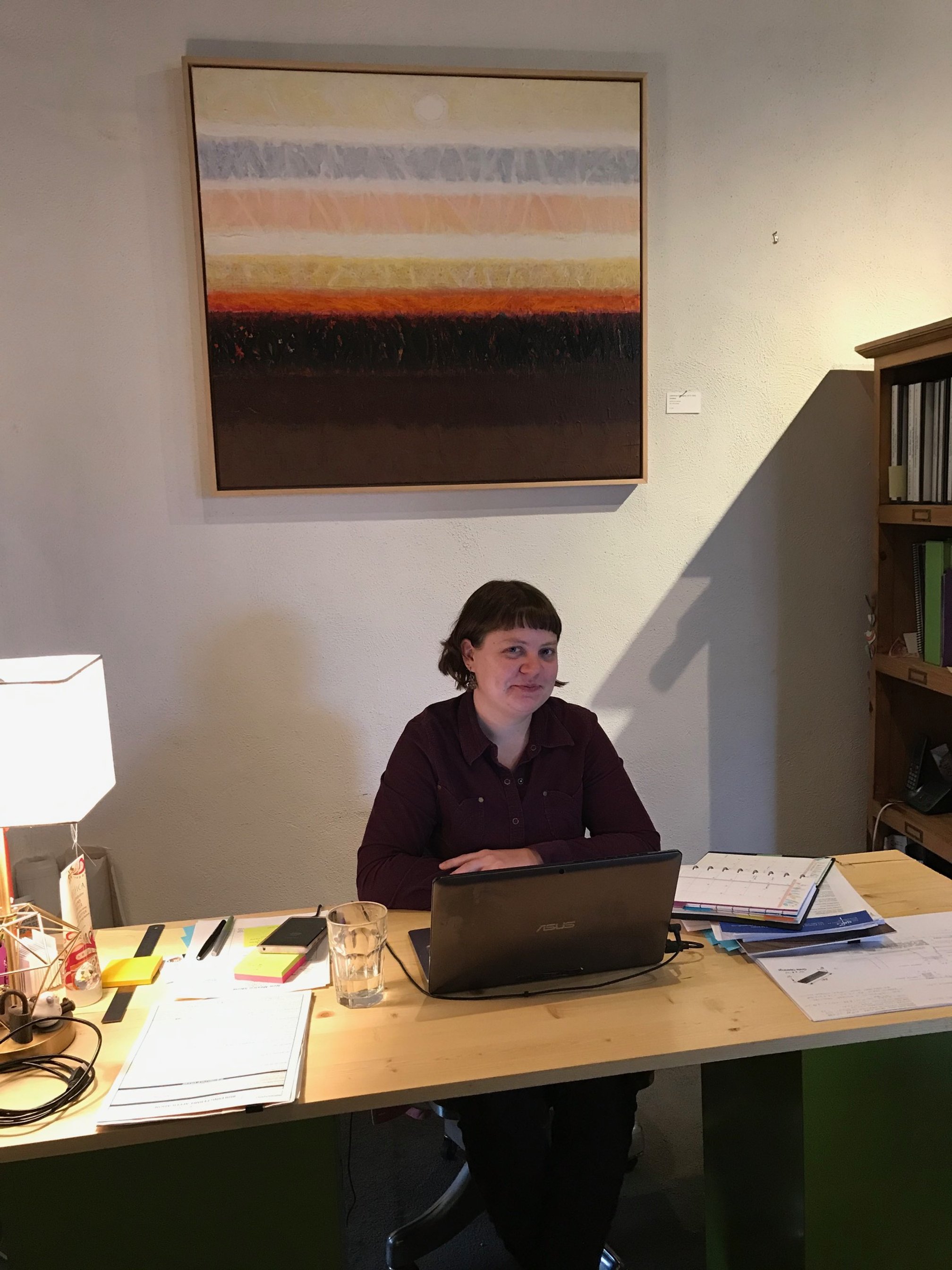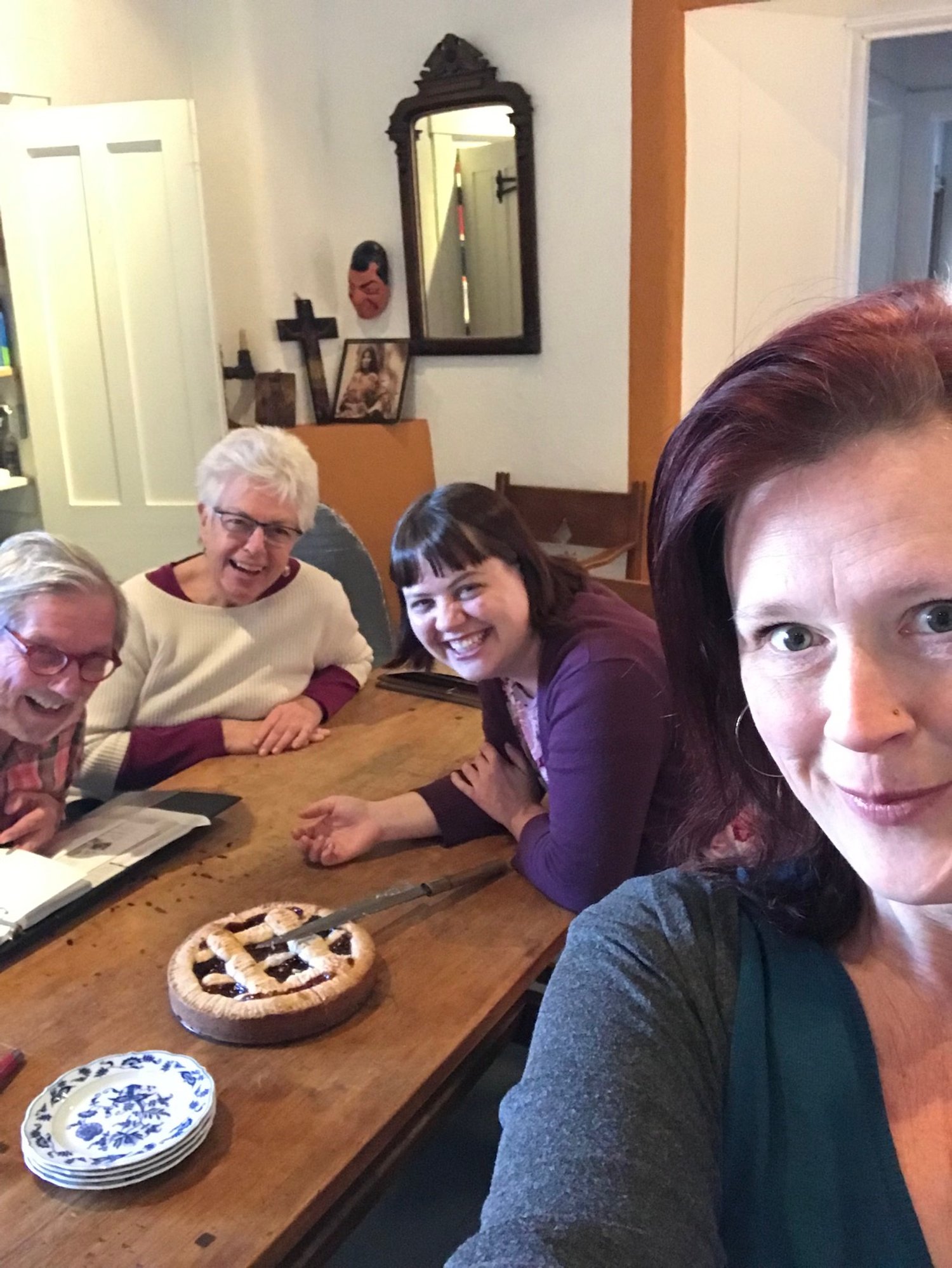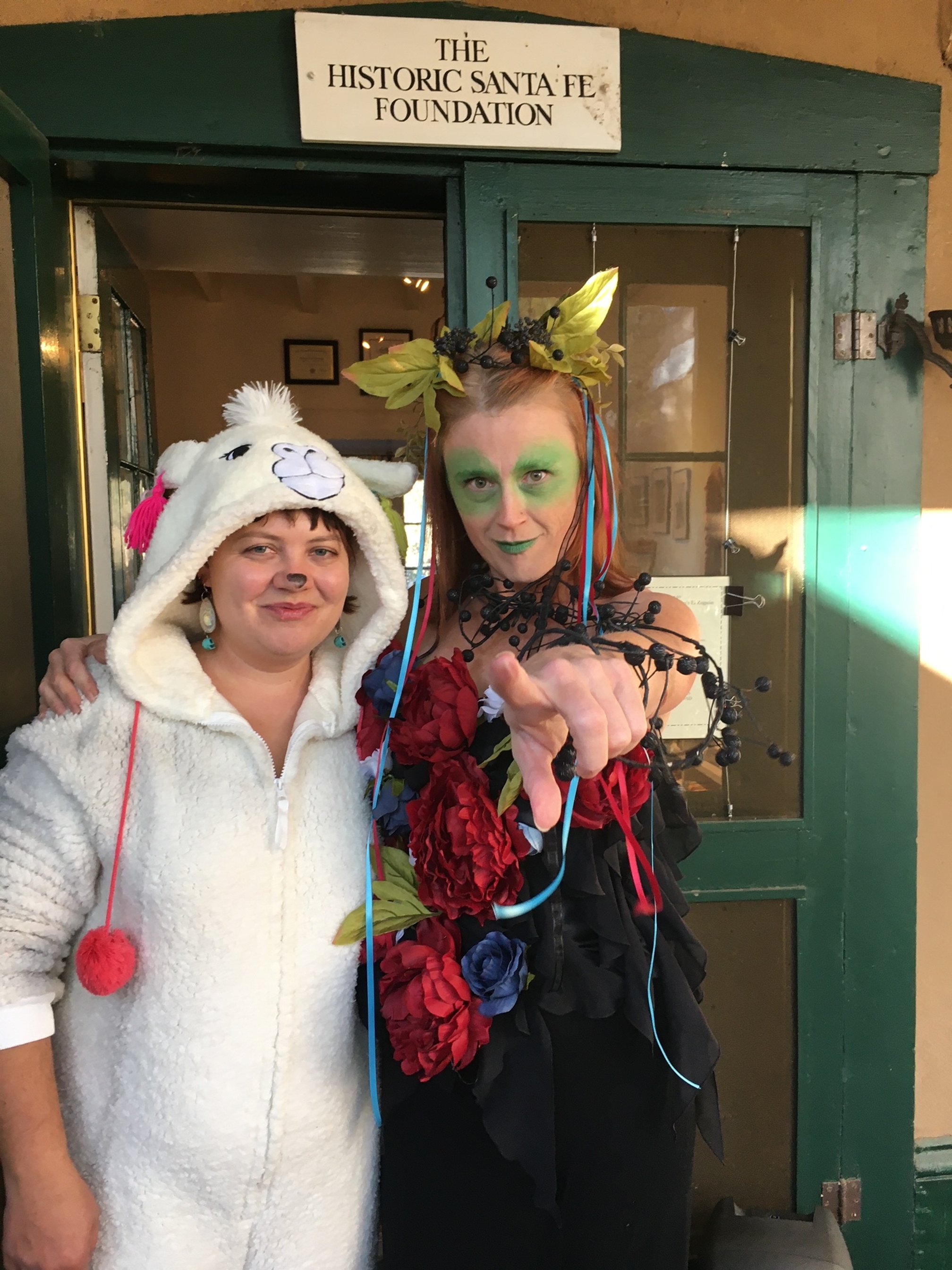Brian Paccione and Jon Vigil on Capturing the Spirit and Resilience of Las Trampas
/Interview by Hanna Churchwell, HSFF Education & Communications Coordinator
Historic Santa Fe Foundation (HSFF) Executive Director Pete Warzel invited Brian Paccione to our offices at El Zaguán last summer to discuss ALABADO, a documentary film– currently in production– exploring the spiritual lives of Las Trampas' Hispano community. Shortly after the meeting, HSFF became the fiscal sponsor for Brian’s project. This spring I traveled to Las Trampas to plan HSFF’s upcoming event at San José de Gracia Church and met with Brian and ALABADO’s co-producer Jon Vigil. Our conversation veered from event logistics to their relationship with each other, the community of Las Trampas, and filmmaking and later motivated the questions asked in the interview below.
Brian paccione (LeFT) and Jon Vigil (right)
Hanna Churchwell (HC): What brought you together? What was the catalyst for making a documentary film about the community of Las Trampas?
Brian Paccione (BP): I was navigating a very difficult time in my life and as New Mexico does for so many people who are working to understand pain and loss, the place beckoned to me. I did not know where I was going or what my journey meant– but on a hot day in early July I drove into Las Trampas…and San José de Gracia Church spoke to me. I could hear it breathing, through its skin– generations of mud. The church was (and still is) very much alive to me. As expected, it was locked, but a rough and tender local guy, Leroy Aguilar (RIP), pointed to a small home up the hill– “If you want to see the church, knock on that door.” I knocked on the door and met Jon– and the rest is history. For the next six years, I came back to Las Trampas a few times a year. It was a place that somehow understood me– and I felt it was asking me to understand it better. It felt right to spend time with the people who lived there, deepen my friendship with Jon, and learn why I felt such a deep connection to this land, its history, and the culture it expressed. Four years ago, another period of loss brought me back to Las Trampas to heal. But this time, I took a deeper step towards my connection to the village. I wanted to make contact with this community in a more intentional, spiritual, and focussed way – and the only way I know how to do that is to make a film. Working with Jon is something that is hard to put into words. Jon is one of my best friends. It could have been anyone behind that door ten years ago. But it was Jon. My friendship with Jon is one of the things I am most grateful for in my life. It has been a source of strength in some of the most difficult times. We help each other. We are bonded by our struggles and are committed to the same spiritual journey. He inspires me and has taught me so much. It’s a very special thing.
HC: Can you say a few words about several events which recently impacted the village and the role they have played in shaping the outcomes of the community of Las Trampas?
BP: Our film opens with the death of Jose Liberato Lopez, the mayordomo of the San José de Gracia Church. Jose was the leader of the Las Trampas community and was a powerful unifying force for the village. His power was expressed in his devotion towards the caretaking of the church. His family has lived in Las Trampas for hundreds of years and Jose protected the knowledge and traditions of this community, holding these families together through economic hardship and changing times. Without Jose, the future of this church– and Las Trampas– was imperiled. Still reeling from Jose’s death, the villagers turn to Rose Vigil, who accepts the responsibility of mayordoma of the church. Rose is the emotional core of Las Trampas. Her heart is big, and her spirit is felt by all. But when Rose is diagnosed with terminal cancer, Las Trampas must not only reckon with the loss of another beloved member of their community, but the reality that their sacred way of life is changing. When Rose passes away from cancer the community is left to deal with the absence of two of its most important members. Our film creates a space for their absence, a time to mourn this loss, and a journey towards rebirth and renewal for the Las Trampas community.
HC: Can you elaborate a bit on the themes of spirituality and community in your film? How would you describe the interplay between ancestral rituals and contemporary society in Las Trampas?
BP: As the Chicano elders of Northern New Mexico pass away, so do their rituals. The tools used to cope with loss and heal from trauma are fading. These communities are predominantly senior– the young people are leaving and have no interest in an agrarian life tied to the land. Drugs are a serious problem. Our film investigates the drug situation in Northern New Mexico, its effect on these communities and how it has replaced many of the traditional ways of life for these villages. How can a spiritual life prevail when ancestral traditions compete with the social complexities of a contemporary society? How does life go on after the unspeakable happens to us? What can we learn from these communities and their ancestral knowledge? What can they teach us about processing loss? Our film is an investigation of these questions. At a time particularly marked by upheaval and catastrophe, we turn to Las Trampas to better understand how to endure the pain of heartbreak, trauma, and death. The rituals of this Chicano/Hispano community are a metaphorical and literal model of our own communities– and they provide lessons in healing.
HC: Through interviews, ALABADO explores the relationship of individuals to traditions and the broader community in Las Trampas. How important was it for ALABADO to emphasize their stories?
BP: Our film not only preserves the voices, songs, and spirit of this vanishing cultural group for future generations, but functions as an independent creative ceremony that mobilizes the entire Las Trampas community to work on a different kind of “church”– a documentary film– to invite them to reflect on and build their culture. Our film mobilizes the villagers of Las Trampas to participate in the story of their culture by providing an organized opportunity to reflect on their inner lives and express their perspectives. Much like the John Collier Jr. photographs taken in the 1940s, our film not only functions as a valuable reference point for researchers and historians, but as a way for future generations of Hispano/Chicano communities to recognize their identity and be inspired to contribute to the representation of their culture.
HC: Can you speak on your process of conducting interviews?
BP: Our interviews are collaborative conversations. We sit and ask our subjects what they would like to talk about, and we listen to them. We bring curiosity, empathy, and vulnerability. This is an exchange of feelings– a heart-to-heart relationship in which Jon and I share our personal struggles as well.
HC: How has the focus changed over time, especially after having filmed your first round of interviews?
BP: The focus has not changed. The focus was always to celebrate the power of the human heart to endure suffering and engage in a spiritual cycle of life, death, and rebirth.
HC: Of the people you have spoken with so far, and the insights they shared with you, is there one conversation in particular that has resonated with you?
BP: There is a great and deep love for all the participants of our film. I respect them. They have taught me so many things. There is one thing that Ray Pacheco mentioned that I think about a lot. He asks the Lord, “Why? Why all the suffering? And why can’t you take the pain away?” The Lord answered him. “Because,” answers the Lord, “if I took your pain away, then you will forget about me.”
HC: Jon, how would you describe your relationship to Las Trampas, both the community and the built environment, when you were young? How has that relationship evolved over the years, especially with your art and now with ALABADO.
Jon Vigil (JV): I would describe my relationship with the community as being one with everything. I am quite quiet and reserved. I find comfort in observing and connecting with the unique energy that truly exists in this place. I don’t know if it can honestly be described. The energy here is just one of you either feel it and connect or you don’t. My process has always just been one of an observer. I would also add that my relationship with the town has changed much over the years. I am very even keeled and try to just be true to myself, respectful of those I interact with, and allow for whatever it is that is spoken either energetically or otherwise to be listened to. I truly believe one of the reasons Brian and I connected is that both of our energies fit with this place and the spirit of these mountains. It’s a very serene presence. We both understand there is something that is very special here. We both have worked to be at one with everything and allow for the process to unfold as it sees fit. The process in this film has been quite difficult at times. Many of the subjects in the film are very close to me. Some family and some very close friends. It can be very hard to sit back and listen to them speak on very difficult subject matter at times. As an empath I absorb so much of what’s around me so I try my best to balance all of that while at the same time trying to just be an objective listener.
HC: Brian, your films share common themes of love, loss, and faith. Have your prior experiences navigating those themes informed your approach to making ALABADO?
BP: Yes. It is all I am interested in, and I think it’s what makes my work useful to me and hopefully useful to others. I have very deep questions about these things– how to love, how to let go, what it all means– and I turn to the artistic gestures of others to understand these questions better. All I want to do is to be a part of that tradition– of making things that people can use to hopefully understand how to love better. I try to design a process that helps me, the people in my film, and the audience do that. Making films is therapy.
HC: The shots featured in the teaser are intimate and immersive. What inspired the visual language of the film?
BP: The visual language is inspired by tapping into the energy of the mountains and the soul of the people who live under them. In many ways, the energy of the place and the people there tell you where to put the camera– you cannot impose, this is about listening– and it is a very intuitive thing. We come very highly sensitized and ready to serve the energy that is presented to us. We follow the light, and the light shows us where to go. You mention intimacy. Intimacy is a very important word for me. It is all about healthy intimacy. Everything I do is aiming for intimacy. For me, it is about understanding. It is about getting close and private and sharing in a moment.
HC: Where are you in the production process? What are some of the obstacles you have encountered during production?
BP: We have around 65% of the film shot. We will be shooting the remaining 35% of the film in June 2023. As far as my personal obstacles, I recognize I am an outsider. It has taken years of visiting and thinking and feeling my way through this community to feel that I was ready to engage creatively with it. I am still learning and still responding and changing and adapting my approach. Many of our obstacles have been the mistakes of those who came before us– the carelessness of simplistic representation in the media, the greed of corporate industrialization/nuclearization, and the violence of colonization. Through patience, conversation, and collaboration we work very hard to ensure that this community understands we are here to listen and make something beautiful together. We are here to build trust and ensure that our intentions are clear. There is also a personal obstacle, which is just the nature of documentary filmmaking– these projects take time. This is good, since it means continued sensitization and continued reflection– but I think it’s difficult for any artist to sit with a project for years, through chapters of your life and the lives of the participants. It’s a long journey.
HC: Who are you making this documentary for and what do you hope your audience takes away from watching it? Or What do you hope the takeaways are for people from Las Trampas who will watch the film? And for viewers outside of the community?
BP: Our film takes this position confidently: that there are forces at work more powerful than we are, there are energies that bind us together, and that the echo of those who came before us can be felt and seen if we open our eyes wide enough. Our process and technique is forged from this perspective. Our film is a prayer. The theater is our church, and our audience are parishioners. In the darkness, they are here to reckon with themselves while asking silent energies for guidance and answers. Through the drama of light, angle, silence, and composition, our visual and auditory approach is designed to bring an audience to their knees, open them to spiritual communication, and encourage them, regardless of belief, to connect with the primal gesture of submission, meditation, and inner conversation. I believe in the power of a creative act to heal. I believe in equating this creative gesture to a sacred ritual. I believe in the resulting creative object to serve as a vessel between the spiritual world and our waking life. I believe that cinema has the ability to make the transcendent sensorial. Our film is an expression of these ideals. It is a sacred invitation to silent reflection, communal action, and spiritual awakening. I hope the people from Las Trampas watch our film and are proud. I want them to be proud of who they are and where they come from. I want them to share and celebrate who they are, together and with love. At the end of the day, I just want to make something beautiful. Not aesthetically– that counts, yes– but beautiful as in truthful and pure of heart.
HC: Is there anything you would like to add?
BP: We need your help. Making films is very difficult and very expensive. This is a personal film– it is built with our own sweat and blood. It is made with our hearts. For years, this film has been financed only by us. We have saved and have worked very hard for this story– and we will not be able to complete the film unless we receive additional support. We will need an additional $10,000 to bring the story of Las Trampas to you. This money ensures that we work ethically and responsibly in a way that reflects and respects the spirit of this story. Thank you for the opportunity to share our hearts with you– and we invite you to take this journey with us.
JV: In very difficult periods of my life, I have literally had angels show up at my doorstep. Brian has been one of those angels. We have weathered some very strenuous phases of life together and will continue to weather many more. The process for this film started at one of those points in life where we both needed healing from the difficulties life throws. This film begins with the community getting hit with some heavy blows. I truly believe that this film can be the angel the Las Trampas community as a whole needs in its time of need. We both have found so much healing in this process and hope to spread that healing beyond just the two of us. The support given to us in doing this project has been something neither of us will ever forget. We appreciate it more than any words could ever say.
Initial funding for the project has been granted to Brian Paccione by the Eugene V. and Clare E. Thaw Charitable Trust with the Historic Santa Fe Foundation serving as fiscal sponsor for this grant. Additional funding is appreciated. Donate to the project here.
ABOUT BRIAN (DIRECTOR, PRODUCER, CINEMATOGRAPHER)
Brian Paccione's films have enjoyed international recognition for their spiritual, sensitive, and passionate accounts of love, loss, and faith. He holds a BA in both film and biology from Vassar College as well as an MFA from the Columbia University Graduate Film program. In addition to writing and directing his own work, Brian currently teaches film production at SUNY Purchase College and Brooklyn College. For more information on Brian's work visit his website.
ABOUT JON VIGIL (PRODUCER, CINEMATOGRAPHER)
Jon Vigil has spent more than a decade as a freelance videographer and photographer in his native state of New Mexico. Inspired by all that is unique to the region, Jon found his voice in the same adobe home where his great grandfather Juan Lopez once lived. Jon's personal projects serve to celebrate and preserve the culture of his family and his village in Northern New Mexico.


